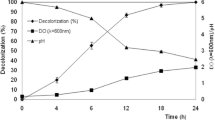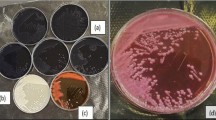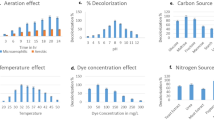Abstract
Removal of azo dyes from the effluent generated by textile industries is rather difficult. Azo dyes represent a major class of synthetic colorants that are both mutagenic and carcinogenic. Galactomyces geotrichum MTCC 1360, a yeast species, showed more than 96% decolorization of the azo dye Remazol Red (50 mg/L) within 36 h at 30°C and pH 11.0 under static condition with a significant reduction in the chemical oxygen demand (62%) and total organic carbon (41%). Peptone (5.0 g/L), rice husk (10 g/L extract), and ammonium chloride (5.0 g/L) were found to be more significant among the carbon and nitrogen sources used. The presence of tyrosinase, NADH-DCIP reductase, riboflavin reductase and induction in azo reductase and laccase activity during decolorization indicated their role in degradation. High performance thin layer chromatography analysis revealed the degradation of Remazol Red into different metabolites. Fourier transform infrared spectroscopy and high performance liquid chromatography analysis of samples before and after decolorization confirmed the biotransformation of dye. Atomic absorption spectroscopy analysis revealed a less toxic effect of the metabolites on iron uptake by Sorghum vulgare and Phaseolus mungo than Remazol Red dye. Remazol Red showed an inhibitory effect on iron uptake by chelation and an immobilization of iron, whereas its metabolites showed no chelation as well as immobilization of iron. Phytotoxicity study indicated the conversion of complex dye molecules into simpler oxidizable products which had a less toxic nature.
Similar content being viewed by others
References
Kalyani, D. C., A. A. Telke, R. S. Dhanve, and J. P. Jadhav (2009) Ecofriendly biodegradation and detoxification of Reactive Red 2 textile dye by newly isolated Pseudomonas sp. SUK1. J. Hazard. Mater. 163: 735–742.
Phugare, S. S., D. C. Kalyani, A. V. Patil, and J. P. Jadhav (2010) Textile dye degradation by bacterial consortium and subsequent toxicological analysis of dye and dye metabolites using cytotoxicity, genotoxicity and oxidative stress studies. J. Hazard. Mater. 186: 713–723.
Waghmode, T. R., M. B. Kurade, and S. P. Govindwar (2011) Time dependent degradation of mixture of structurally different azo and non azo dyes by using Galactomyces geotrichum MTCC 1360. Int. Biodeter. Biodegrad. 65: 479–486.
Kumar, K., D. S. Saravana, K. Krishnamurthi, S. Gampawar, N. Mishra, G. H. Pandya, and T. Chakrabarti (2006) Decolorisation, biodegradation and detoxification of benzidine based azo dye. Bioresour. Technol. 97: 407–413.
Telke, A. A., D. C. Kalyani, V. V. Dawkar, and S. P. Govindwar (2009) Influence of organic and inorganic compounds on oxidoreductive decolorization of sulfonated azo dye C. I. Reactive Orange 16. J. Hazard. Mater. 172: 298–309.
Tamboli, D. P., A. N. Kagalkar, M. U. Jadhav, J. P. Jadhav, and S. P. Govindwar (2010) Production of polyhydroxyhexadecanoic acid by using waste biomass of Sphingobacterium sp. ATM generated after degradation of textile dye Direct Red 5B. Bioresour. Technol. 101: 2421–2427.
Ali, N., A. Hameed, S. Ahmed, and A. G. Khan (2008) Decolorization of structurally different textile dyes by Aspergillus niger SA1. W. J. Microbiol. Biotechnol. 24: 1067–1072.
Zhou, Q., J. Xu, and Y. Cheng (2004) Inhibitory effects of Reactive X-3B Red dye (RRD) on iron uptake by three Crops. Plant. Soil. 261: 155–162.
Pascal, N. and R. Douce (1993) Effect of iron deficiency on the respiration of Sycamore (Acer pseudoplatanus L.) cells. Plant. Physiol. 103: 1329–1338.
APHA (1998) Standard Method for the Examination of Water and Wastewater, 20th ed. American Public Health Association, 2120 E, Washington, DC, USA.
Gomare, S. S., S. D. Kalme, and S. P. Govindwar (2009) Biodegradation of Navy Blue-3G by Brevibacillus laterosporus MTCC 2298. Acta. Chim. Slov. 56: 789–796.
Tamboli, D. P., M. B. Kurade, T. R. Waghmode, S. M. Joshi, and S. P. Govindwar (2010) Exploring the ability of Sphingobacterium sp. ATM to degrade textile dye Direct Blue GLL, mixture of dyes and textile effluent and production of polyhydroxyhexadecanoic acid using waste biomass generated after dye degradation. J. Hazard. Mater. 182: 169–176.
Kandaswami, C. and C. S. Vaidyanathan (1973) Oxidation of catechol in plants. IV. Purification and properties of the 3,4,3′,4′ tetrahydroxydiphenyl forming enzyme system from Tecoma leaves. J. Biol. Chem. 248: 4035–4039.
Telke, A. A., S. M. Joshi, S. U. Jadhav, D. P. Tamboli, and S. P. Govindwar (2010) Decolorization and detoxification of Congo Red and textile industry effluent by an isolated bacterium Pseudomonas sp. SU-EBT. Biodegradation. 21: 283–296.
Kapdan, I. K., F. Kargi, G. McMullan, and R. Merchant (2000) Effect of environmental conditions on biological decolorization of textile dyestuff by C. versicolor. Enz. Microbial. Technol. 26: 381–387.
Jadhav, U. U., V. V. Dawkar, A. A. Telke, and S. P. Govindwar (2008) Decolorization of Direct Blue GLL with enhanced lignin peroxidase enzyme production in Comamonas sp UVS. J. Chem. Technol. Biotechnol. 84: 126–132.
Dubey, A., N. Mishra, N. Singh, A. Deb, and S. Verma (2010) Isolation of dye degrading microorganism. Electron. J. Environ. Agri. Food Chem. 9: 1534–1539.
Jadhav, S. B., S. S. Phugare, P. S. Patil, and J. P. Jadhav (2011) Biochemical degradation pathway of textile dye Remazol Red and subsequent toxicological evaluation by cytotoxicity, genotoxicity and oxidative stress studies. Int. Biodeter. Biodegrad. 65: 1–11.
Aksu, Z., N. K. Kilic, S. Ertugrul, and G. Donmez (2007) Inhibitory effects of chromium (VI) and Remazol Black B on chromium (VI) and dyestuff removals by Trametes versicolor. Enz. Microbial. Technol. 40: 1167–1174.
Chen, K. C., J. Y. Wu, D. J. Liou, and S. C. J. Hwang (2003) Decolorization of the textile dyes by newly isolated bacterial strains. J. Biotechnol. 101: 57–68.
Qingxiang, Y., T. Lingxia, Y. Min, and Z. Hao (2008) Effects of glucose on the decolorization of Reactive Black 5 by yeast isolates. J. Environ. Sci. 20: 105–108.
Niebisch, C. H., A. K. Malinowski, R. Schadeck, D. A. Mitchell, V. K. Cordeiro, and J. Paba (2010) Decolorization and biodegradation of Reactive Blue 220 textile dye by Lentinus crinitus extracellular extract. J. Hazard. Mater. 180: 316–322.
Parshetti, G. K., A. A. Telke, D. C. Kalyani, and S. P. Govindwar (2010) Decolorization and detoxification of sulfonated azo dye methyl orange by Kocuria rosea MTCC 1532. J. Hazard. Mater. 176: 503–509.
Zhou, Q. (2001) Chemical pollution and transport of organic dyes in water-soil-crop system of the Chinese coast. Bull. Environ. Contam. Toxicol. 66: 784–793.
Author information
Authors and Affiliations
Corresponding author
Rights and permissions
About this article
Cite this article
Waghmode, T.R., Kurade, M.B., Kabra, A.N. et al. Degradation of Remazol Red dye by Galactomyces geotrichum MTCC 1360 leading to increased iron uptake in Sorghum vulgare and Phaseolus mungo from soil. Biotechnol Bioproc E 17, 117–126 (2012). https://doi.org/10.1007/s12257-011-0307-0
Received:
Revised:
Accepted:
Published:
Issue Date:
DOI: https://doi.org/10.1007/s12257-011-0307-0




